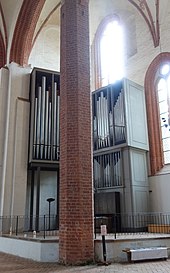Katharinenkirche (Salzwedel)
The Katharinenkirche is one of the large churches in the city of Salzwedel in the north-west of Saxony-Anhalt . It is of Romanesque origin, but is attributed to the brick Gothic. Its namesake is Saint Catherine .
history
The Neustadt district of Salzwedel was founded in 1247. The first documented construction of the Katharinenkirche was in 1280. It was built as a parish church for the new town. Extensions were made at the beginning of the 14th century. A choir was built on the east side of the nave , which was higher than the nave . Around 1450 the entire church was extended to this height. In addition, it received a vault. The next expansion took place in 1460. In 1467 the Corpus Christi chapel was completed. A two-storey sacristy annex was built on the south side ; the spire was renewed. The church had almost reached its present form. The original nine stained glass windows in the choir, three of which have survived, also date from that time. They show scenes from Genesis and from the life of Christ . Since the arrival of the Reformation in Salzwedel, the parish has been Evangelical-Lutheran .
On August 7, 1644, the spire burned after a lightning strike. In the second half of the 19th century, what was then the main altar was sold to the Frankfurt Cathedral , where it now forms the middle section of the high altar . In 1981, the so-called unicorn altar from the Dambeck monastery church took its place . Another carved altar previously stood in the Salzwedel monks' church and was set up in the Katharinenkirche in 1947 for the 700th anniversary of the Neustadt.
Katharinenkirche remained intact during the Second World War, but fell into disrepair in the decades that followed. On Christmas Eve 1961, the last Christmas Vesper for the time being was celebrated in the church. The church was abandoned as the walls threatened to drift apart. After 1974, the restoration of the church began with the help of numerous volunteers. On Christmas Eve 1975, services could be celebrated again in the Katharinenkirche for the first time. In 1978 a new organ from the Schuke company in Potsdam was inaugurated. During the fall of 1989, the Katharinenkirche was the starting point for numerous protests. Even before the renovation work was completed, there was again structural damage in 2010, so that the west hall had to be closed. The fundamental renovation of the west hall lasted until 2013.
The ringing was after the rededication in 1975 only from the apostle bell. It was supplemented by four bells to a full peal in the 2000s.
Architecture and equipment
The Katharinenkirche is a three-aisled brick basilica . On the side aisles there are stepped gables with double panels . The spire is covered with copper . On the south side there is the oldest preserved portal of the church and a modern sundial .
There are no galleries inside the church . There are two carved altars: the larger one dates from 1474 and in the middle part contains the rare depiction of a unicorn escaping into Mary's lap . In the north aisle there is another St. Mary's altar, which also dates from the 15th century. It belonged to the church of the deserted village of Bukau. The bronze funtion dates from 1421, the corresponding lattice from 1567. One of the jewels of the Katharinenkirche is a silver and gold kiss tablet from 1521.
The church has a library with a large number of books from the 16th century on the Reformation.
organ
The organ in St. Katharinen was built in 1978 by Alexander Schuke from Potsdam. The instrument has 27 sounding registers on two manuals and a pedal . The playing and stop actions are mechanical.
The disposition of the organ:
|
|
|
|||||||||||||||||||||||||||||||||||||||||||||||||||||||||||||||||||
- Coupling : II / I, I / P, II / P
use
Church services are held weekly and on public holidays. Exhibitions on religious topics are held regularly. The church is often used for concerts as part of the “Church Music in Salzwedel”. The Katharinengemeinde also looks after churches south of Salzwedel, such as the Dambeck village church .
Surroundings
The church is surrounded by an ensemble of historic houses, mostly half-timbered houses , and an old stock of trees, including a winter linden tree planted in 1761 , which, like several other trees on the church, is a natural monument . On the east side is the former Neustädter Latin School , which serves as the parish hall of the church. There used to be a port nearby at the confluence of the Jeetze and Dumme rivers .
literature
- Monika Böning (author), Ulrich Hinz (regest part): The medieval glass paintings in Salzwedel (= Frank Martin on behalf of the Berlin-Brandenburg Academy of Sciences [Hrsg.]: Corpus Vitrearum Medii Aevi . Germany Volume XIX, 3rd Saxony-Anhalt North Part 3). Akademie Verlag, Berlin 2013, ISBN 978-3-05-005077-5 , Parish Church St. Katharinen, pp. 151-219 ( full text in Corpus Vitrearum Medii Aevi [PDF; 16.9 MB; accessed on November 12, 2019]) .
Web links
- Website of the Katharinenkirchen Congregation
- Report on structural damage to the Katharinenkirche, history and furnishings
Individual evidence
- ↑ a b c Hartmut Bock et al .: The north-western Altmark - a cultural landscape . Sparkasse Gifhorn-Wolfsburg, Wolfsburg 1991, without ISBN, pp. 125–127
- ↑ a b c Report on structural damage to the Katharinenkirche , accessed on May 19, 2010
- ↑ a b Website of the Katharinenkirchen Community , accessed on May 18, 2010
- ↑ Spelling according to information pamphlets in the Katharinenkirche
Coordinates: 52 ° 51 ′ 20.4 " N , 11 ° 9 ′ 21.4" E







